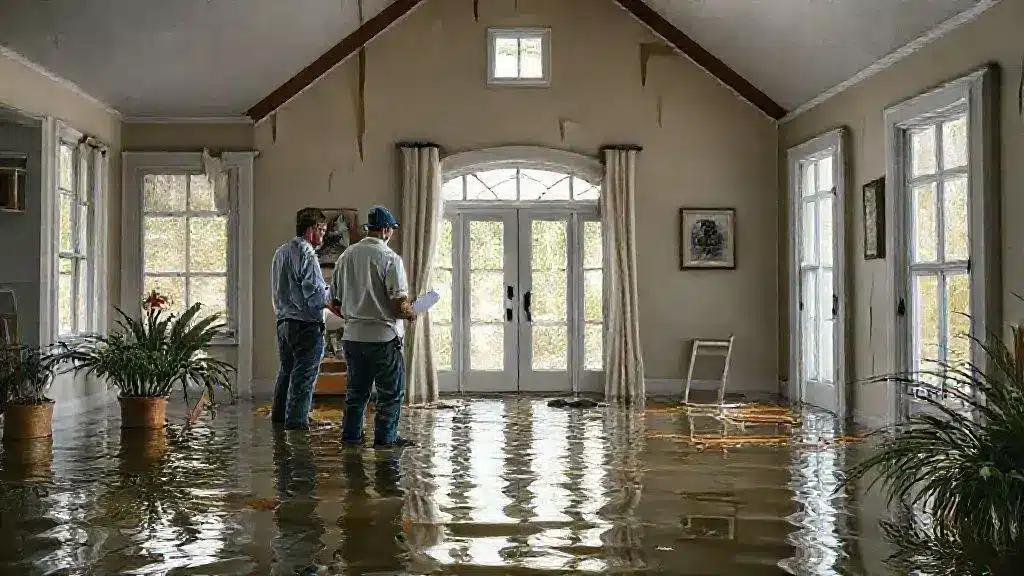Home insurance claims spike after natural disasters

Home insurance claims spike after natural disasters, so understanding your coverage, documenting damages, and filing promptly can maximize your payout.
Home insurance claims spike after natural disasters, often leaving homeowners confused about the process. Have you considered how these events may impact your coverage? Let’s explore the ins and outs of filing claims during these challenging times.
Understanding the impact of natural disasters on claims
Natural disasters can have a tremendous impact on home insurance claims. Understanding how these events affect your policy is essential for any homeowner. It often leads to a surge in claims, putting pressure on both insurance companies and policyholders.
Types of Natural Disasters
Various types of natural disasters can lead to significant home damage and increased claims. Being aware of these can help you better understand your risks.
- Hurricanes: These storms can cause severe wind and water damage.
- Earthquakes: Sudden shakes can lead to foundational issues and structural collapse.
- Floods: Often associated with heavy rainstorms, floods can ruin homes quickly.
- Wildfires: These can rapidly consume properties, especially in dry areas.
When a natural disaster strikes, the first step is to assess the damage. Homeowners should document everything meticulously. This includes taking pictures and writing down the extent of the damage. The more evidence you have, the better your chances of a successful claim. Home insurance claims can be complicated, especially during peak times when many homeowners are filing at once.
Time Sensitivity in Claim Filing
It’s crucial to file claims as soon as possible. Delays can lead to further complications and may even result in denied claims. Each insurance policy has specific timelines for reporting damage. Understanding these timelines is critical for homeowners.
Additionally, working closely with your insurance agent can provide clarity during stressful times. They can guide you through the claims process, helping to lessen confusion as you deal with the aftermath of a natural disaster. Keep in mind that every policy is different, and knowing your coverage can make a significant difference in how claims are processed.
Common types of natural disasters affecting homeowners
Homeowners need to be aware of the common types of natural disasters that can adversely affect their properties. Understanding these risks helps in preparing and protecting your home effectively. Various disasters can impact homes differently, often resulting in damage that requires homeowners to file an insurance claim.
Hurricanes
Hurricanes are severe storms that bring strong winds and heavy rainfall. This combination can lead to substantial damage. Homeowners should be particularly cautious about:
- Wind damage: High winds can uproot trees and damage roofs.
- Water intrusion: Flooding can occur from heavy rains and storm surges.
- Infrastructure issues: Streets and utilities can get disrupted, making recovery harder.
Being prepared for hurricanes involves more than just securing property; it often means understanding the insurance policies that cover such events.
Earthquakes
Earthquakes can strike suddenly and can cause severe structural damage. A single tremor can crack foundations and destroy drywall. Homeowners need to consider:
- Retrofitting homes: Structurally reinforcing homes can minimize damage.
- Insurance coverage: Not all policies cover earthquake damage, so checking your policy is vital.
- Preparedness plans: Have an emergency plan in place for your family.
Preparation for earthquakes is crucial, particularly in regions prone to seismic activity.
Floods
Flooding can occur without warning. Whether from heavy rain or a burst pipe, the damage can be extensive. Homeowners should note the following:
- Basement damage: Water can quickly accumulate in basements, leading to mold growth.
- Property loss: Household items can be ruined by water damage.
- Insurance considerations: Standard homeowners insurance may not cover flood damage, requiring separate flood insurance.
Being proactive about flooding can save homeowners from significant distress and loss.
Wildfires
Wildfires can threaten homes, especially in regions prone to dry conditions. Homeowners should be vigilant about:
- Creating defensible space: Clearing vegetation can reduce fire risk.
- Insurance policies: Understanding what your insurance covers in the event of a fire.
- Evacuation plans: Always be prepared to evacuate if necessary.
Understanding these disasters is vital for every homeowner. Preparation can make all the difference when facing any of these natural threats.
How to prepare your home for future disasters

Preparing your home for future disasters is crucial for minimizing damage and ensuring the safety of your family. Being proactive can make a significant difference when facing unexpected events. There are several strategies homeowners can implement to protect their properties.
Assessing Risks
The first step in preparation is understanding the specific risks associated with your area. Are you near a flood zone? Is your home in a region that experiences hurricanes or earthquakes? Identifying these risks helps tailor your preparedness plan.
- Research local hazards: Know the types of disasters typical in your region.
- Inspect your property: Identify vulnerable areas that may require reinforcement.
- Stay informed: Monitor weather alerts and community warnings.
Knowledge of risks allows homeowners to take necessary precautions to protect their homes.
Creating an Emergency Plan
An effective emergency plan is essential for any household. This plan should outline steps to take before, during, and after a disaster. Here are key components to consider:
- Family communication: Establish how family members will communicate if separated.
- Evacuation routes: Identify multiple escape routes from your home.
- Meeting point: Choose a safe location for everyone to gather.
Regularly review and practice the plan to ensure everyone knows their role during an emergency. Having a clear plan can significantly reduce confusion and fear.
Strengthening Your Home
Another critical aspect is strengthening your home against potential disasters. This can involve physical modifications and upgrades. Here are some options:
- Reinforcements: Use hurricane straps to secure the roof and increase wind resistance.
- Flood barriers: Install sandbags or flood shields to protect against rising waters.
- Earthquake retrofitting: Secure heavy furniture and appliances to walls.
Taking these steps can enhance your home’s resilience, making it better equipped to withstand various disasters.
Filing a claim: Steps to take after a disaster
Filing a claim after a disaster can be overwhelming, but taking the right steps can help ensure a smoother process. Knowing what to do immediately after the event is essential for homeowners who want to recover quickly.
Immediate Actions
After a disaster strikes, prioritize safety first. Ensure that you and your family are safe. Once everyone is okay, it’s time to assess the damage to your property.
- Document the damage: Take pictures and videos of all affected areas inside and outside your home.
- Make temporary repairs: If it’s safe, cover broken windows or roofs to prevent further damage.
- Keep records: Save all receipts for repairs and temporary housing to support your claim.
These initial actions are not only vital for your safety but also crucial for your insurance claim.
Contact Your Insurance Company
Your next step should be to contact your insurance company as soon as possible. Each insurance provider has specific procedures for filing claims after a disaster.
- Report the damage: Provide a clear description of what happened and the extent of the damage.
- Understand coverage: Review your policy to know what is covered and any deductibles that may apply.
- Ask questions: Don’t hesitate to ask your agent for guidance on how to proceed.
Clear communication with your insurance company can help reduce misunderstandings and expedite the claims process.
Complete the Claim Form
Filling out your claim form accurately is key to receiving the compensation you deserve. Be thorough and detailed when providing the necessary information.
- List all damages: Include every item that was damaged or lost.
- Attach documentation: Include photographs, repair estimates, and receipts.
- Keep copies: Make copies of everything you submit for your records.
Completing your claim form thoroughly can speed up the process and minimize the risk of delays.
Follow Up Regularly
After submitting your claim, it’s important to follow up regularly. Contact your insurance adjuster and inquire about the status of your claim.
- Be persistent: If there are delays, don’t hesitate to reach out and ask for updates.
- Provide additional information: Be ready to supply any extra documents if requested.
- Document everything: Keep track of all communications with your insurance company.
Regular follow-ups can help ensure that your claim remains a priority and is processed in a timely manner.
Tips for maximizing your insurance claim payout
Maximizing your insurance claim payout is essential, especially after experiencing a disaster. Understanding how to navigate this process can significantly impact the amount you receive. Implementing effective strategies can make a difference.
Know Your Coverage
The first step to maximizing your payout is understanding your insurance policy. Each policy may have different coverage options and limits. You should:
- Review your policy: Familiarize yourself with what is covered and any deductibles.
- Understand exclusions: Be aware of what your policy does not cover.
- Consult your agent: Ask questions to clarify any points you don’t understand.
By knowing your coverage, you can make informed decisions when filing your claim.
Document Everything
Documenting the damage is crucial in the claims process. Proper documentation helps prove your case to the insurance company. Here’s how to do it:
- Take photos: Capture images of all damage before making repairs.
- Keep receipts: Save all expenses related to the damage and repairs.
- Create an inventory: List all damaged items along with their value.
Thorough records of your claim will strengthen your case and provide clarity during the review process.
File Your Claim Promptly
Timing is essential when it comes to filing a claim. Insurance policies typically have deadlines for submitting claims. To ensure a successful payout:
- File quickly: Contact your insurance company as soon as possible after the disaster.
- Follow the process: Ensure you complete all necessary paperwork and provide required documentation.
- Keep copies: Retain copies of everything you submit.
Filing promptly can influence how quickly and effectively your claim is processed.
Be Persistent and Communicative
Effective communication with your insurance adjuster is key to maximizing your payout. Stay engaged throughout the process by:
- Following up: Regularly check in with your adjuster for updates on your claim.
- Being polite but assertive: If you encounter issues, calmly advocate for your needs.
- Providing additional information: Be ready to submit more documents if requested.
Persistence can lead to better outcomes and faster resolutions when dealing with insurance matters.
FAQ – Frequently Asked Questions about Home Insurance Claims
What should I do first after a disaster strikes my home?
Ensure your safety and then document the damage by taking photos and videos before making any repairs.
How can I maximize my insurance claim payout?
To maximize your payout, know your coverage, document all damage thoroughly, file your claim promptly, and communicate regularly with your adjuster.
Is it necessary to keep receipts when filing a claim?
Yes, keeping receipts for all repairs and expenses related to the damage is vital to support your claim.
What if my insurance claim is delayed?
If your claim is delayed, stay persistent by following up with your insurance adjuster for updates and additional information they may need.





